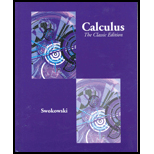
(a)
To calculate: The length of each subinterval of the numbers
(a)
Answer to Problem 1E
The length of each subinterval of the numbers
Explanation of Solution
Given information:
The numbers
Formula used:
For a closed interval of the form
Consider a
Calculation:
Consider the numbers
Recall that for a closed interval of the form
Consider a
Denote the numbers
Now, the length of the subinterval
Therefore, the length of the subinterval
Next, the length of the subinterval
Therefore, the length of the subinterval
Next, the length of the subinterval
Therefore, the length of the subinterval
Next, the length of the subinterval
Therefore, the length of the subinterval
Last, the length of the subinterval
Therefore, the length of the subinterval
Thus, the length of each subinterval of the numbers
(b)
To calculate: The norm
(b)
Answer to Problem 1E
The norm
Explanation of Solution
Given information:
The numbers
Formula used:
For a closed interval of the form
Consider a
The largest number among all
Calculation:
Consider the numbers
Recall that for a closed interval of the form
Consider a
Denote the numbers
Now, the length of the subinterval
Therefore, the length of the subinterval
Next, the length of the subinterval
Therefore, the length of the subinterval
Next, the length of the subinterval
Therefore, the length of the subinterval
Next, the length of the subinterval
Therefore, the length of the subinterval
Last, the length of the subinterval
Therefore, the length of the subinterval
Hence, the length of each subinterval of the numbers
Recall that the largest number among all
Therefore, highest number is
Thus, the norm
Want to see more full solutions like this?
Chapter 5.4 Solutions
Calculus : The Classic Edition (with Make the Grade and Infotrac)
- 2. Find a matrix A with the following qualities a. A is 3 x 3. b. The matrix A is not lower triangular and is not upper triangular. c. At least one value in each row is not a 1, 2,-1, -2, or 0 d. A is invertible.arrow_forwardFind the exact area inside r=2sin(2\theta ) and outside r=\sqrt(3)arrow_forwardA 20 foot ladder rests on level ground; its head (top) is against a vertical wall. The bottom of the ladder begins by being 12 feet from the wall but begins moving away at the rate of 0.1 feet per second. At what rate is the top of the ladder slipping down the wall? You may use a calculator.arrow_forward
- Explain the key points and reasons for the establishment of 12.3.2(integral Test)arrow_forwardUse 12.4.2 to determine whether the infinite series on the right side of equation 12.6.5, 12.6.6 and 12.6.7 converges for every real number x.arrow_forwarduse Cauchy Mean-Value Theorem to derive Corollary 12.6.2, and then derive 12.6.3arrow_forward
- Algebra & Trigonometry with Analytic GeometryAlgebraISBN:9781133382119Author:SwokowskiPublisher:Cengage
